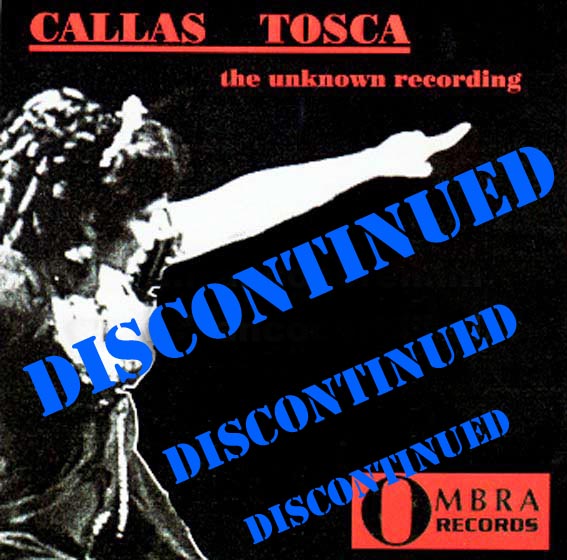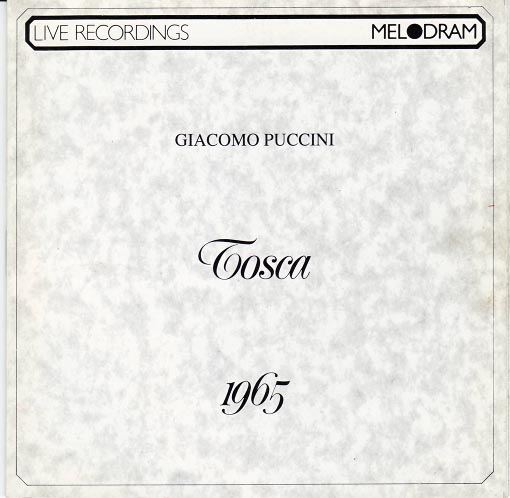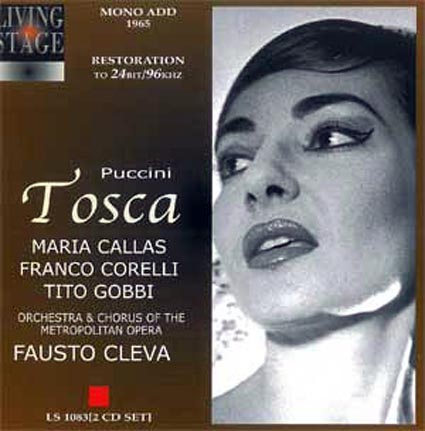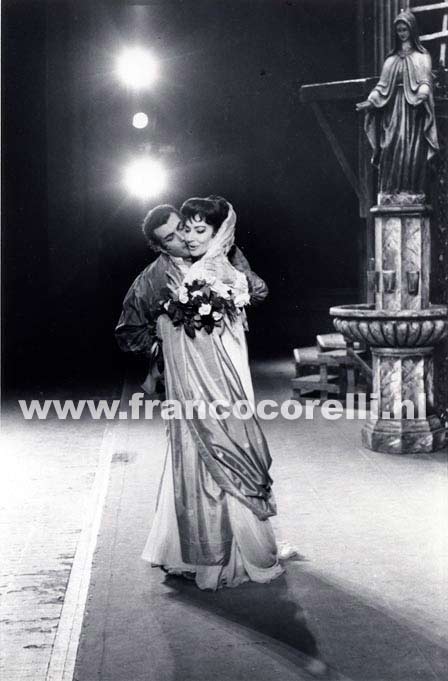GiacomoPuccini
Callas Tosca the unknown recording
|
Composer: Giacomo Puccini Performers: Floria Tosca Maria Callas Chorus and orchestra of the Metropolitan Opera House Compared with: MELODRAM MEL26030 (2 CD)
Compared with: LIVING STAGE LS 1083 (2 CD)
|
To our deep regret and great surprise, OMBRA Records informed us on March 19, 2008, that the Metropolitan Opera has ordered them to discontinue this item. This means that the best sounding issue ever is now discontinued in favor of the inferior Living Stage issue, which apparently continues to be available. Anyone interested in this now Out Of Print OMBRA release that is discussed in the December 2007 review below, will onwards have to rely on the one or two copies that may ever appear on the sales lists of second hand dealers. Our guess therefore is that this former icon in the OMBRA catalogue release will become a genuine collector's item. Our position in this matter is clear: we respect the Metropolitan Opera's copyrights, but at the same time we are very happy to see these treasures released in genuine CD–format (instead of on the inferior CD–R format or mp3 downloads). Like all of you, we wish that the Met were to release their most interesting archive recordings themselves, but we all know that they can't release these recordings because of the copyright limitations that they themselves face within the USA. Alas, the law and the arts do not always have the same interest: many of us feel that we are entitled to hearing some of these historic recordings in one way or another before God blesses our ears with the sound of his Heavenly Choir. We therefore express our deepest sympathies with OMBRA, which has done pioneer's work in the past, and we express the hope that this setback shall not discourage them to continue to do so in the future. Sales pitches such as "coming from a new source and in superior sound to anything available" are not the most reliable slogans on cd covers these days. However, in the case of this discontinued OMBRA OMB7008 2CD release it was true – in fact, it was nearly a dream come true! Before discussing the performance in depth, a few words should be said about the source of this recording, which arrived at OMBRA through the hands of my friend Bruce Badger. No, it was not his recording (he was hardly born when Callas made her triumphant come back at the Metropolitan Opera House in 1965), but rather the recording of the late Marc Scunzio, an usher at the Academy of Music in Philadelphia in the 1960s. Says Mr. Badger: "I never met him, but his name was on several reels in a few boxes of reels that I was given by another collector (who was simply storing them on the floor of his garage). That Tosca was one of the reels. The Philadelphia 1965 Turandot rehearsal was another of the Scunzio reels. I guess that's all to the story. I did my best transferring the Tosca, and was shocked to hear it was a different original than the ones used by Melodram and HRE records. The guy at OMBRA contacted me and asked for the actual reel, but I had returned it to the garage of the other collector (who died shortly after so I couldn't get it back). So I sent him a copy of the CDs." I myself had this transfer for almost a year before this OMBRA release came out, as Mr. Badger copied it for me on behalf of my Corelli biography. It has exactly the same odd 9/16 tracking, which should serve to end any rumors about this tape coming from "secret" Met archives, as has meanwhile been suggested (to my best knowledge, the Met only holds partial rights to their broadcasts, and wasn't allowed to record other performances due to union laws. Hence they didn't record those performances. In cases where recordings appeared, made through the voice system or the prompters box, it always seems to have been done by or at the request of one of the artists – I have some Corelli recordings that were made in this way). Understandably, Mr. Byrne presented his find as "Callas Tosca | The unknown recording" without any reference to the Metropolitan Opera House (for obvious reasons, although Living Stage proudly spells out the correct performance details on their cover, and seemingly without a problem) but it would have been nice if the immediate sources would have been acknowledged on the back cover-art. Even so, it should be stressed that we all, including Mr. Badger, are truly happy to see this infinitely better source recording released by OMBRA so that it is more easily available to obtain for Corelli and Callas fans all over the world. The performanceThe recording itself was always a bit of a rarity. It features Callas and Corelli, two of the most collected artists from their epoche, in Callas' case even of all times, and also Tito Gobbi, but it was never widely distributed or popular. It was released early on only on Melodram and, more recently, on a Living Stage rip of the Melodram (again, no negative implications here, since I don't have the illusion that Melodram went to the Met to tape it themselves). One of the reasons for its lack of popularity is obviously the very poor quality of the Melodram source: the voices are greatly affected by tape fluctuation, making them sound shaky, off pitch and worn. Thus, you have the mistaken idea that Corelli was wobbly in his prime, whereas Callas couldn't be judged because you couldn't tell if the wobble was from the tape fluctuations or born from within. That impression is immediately corrected here: yes, Corelli is audibly nervous in his first bars. Stepping into major arias without having warmed up properly was never his strong suit; also he had to overcome his tremendous stage fright. In this case he was overly concerned about the expected Callas claque. That was because he had heard that Michael Glotz had hired dozens of people to shout bravados for Maria, whereas Bing had only two tickets to spare for Corelli's wife Loretta (On other similar occasions Bing retorted that if someone chose to buy their friends so many – or first class – tickets, that nothing prevented Corelli from doing the same, implying that Franco was stingy). And so, "Recondita armonia" is sung overly cautious at the start, unfolding only from the middle section "ma nel ritrar costei," after which he holds back again in order to save breath for the final belted "Tosca, sei tu!". The clamorous ovation after his aria makes it clear that the public had not just come to see Callas alone, and Corelli clearly drew confidence from that. In the dialogue with Angelotti his voice rapidly gains bite, the texture becoming rounder and warmer. By the time Callas arrives on the scene and he answers "Son qui" to her "Mario! Mario! Mario!," pandemonium breaks out when Callas enters the stage (ultimately one can distinguish some very fervent "Bravo Francos" too, and at the Met Franco wouldn't have had to hire a claque for that). And yet, as I have written before, his Cavaradossi doesn't sound very convincing to me on live recordings, where his obsession to be heard and to dominate frequently interferes with delicacy and poetic atmosphere. Why the duet doesn't tick like the duets Callas sang with Di Stefano earlier is not easily answered. For one thing, her volume is clearly diminished. Corelli, aware of her diminished vocal estate and being a genuine friend of his diva in private as well, clearly tries to adjust himself to the situation. And then, even though this recording is in much better sound than the one previously available, it has some volume problems (either due to the equipment's sensitivity for peak volume or due to the position of the singers on stage or both). |
Hurricane eruptions like Corelli's " Mi avvinci nei tuoi lacci mia sirena" (with a nice diminuedo at the end), or Callas' almost shouted passages after "l'Attavanti!...," somewhat hamper the easy listening quality one is accustomed to in this duet. And, admittedly, Corelli's " Quale occhio al mondo" can't hold a candle to Di Stefano's earlier magic there. In turn, Callas reserves her fireworks for certain passages such as "Ma... falle gli occhi neri!...", or "Certa sono – del perdono se tu guardi al mio dolor!" The attempt of both to impress with volume in the unison section is hardly convincing, although both find the required balance toward the end, onward from "Mia vita, amante inquieta, dirò sempre: "Floria, t'amo!" And when Callas can indulge in ravishing middle register mezza voces, as in "E mi prometti: sia caso o fortuna, sia treccia bionda o bruna, a pregar non verrà donna nessuna!," she is still an impressive artist.
The Angelotti–Cavaradossi scene is a bit brutal, although the agitated tone is perhaps not out of place . However, the difference between an audience recording and a backstage or prompter's box recording, is that here, certain orchestral eruptions can hurt your ears (even the applause can do that in this recording). As for Angelotti, well, Bing paid for three box office stars, which was two more than he would usually be inclined to, and so the scenes with Angelotti and the Sagrestano are but canyons waiting to be crossed. Enter Gobbi. Surprisingly, his voice carries less well than Callas', sounding murky, much in the background and a bit under rehearsed (which goes for Corelli too). Perhaps the orchestral accompaniment is also far from ideal: Cleva 's conducting is uninspired and not very differentiated. Musically, Callas has the upperhand in the encouner between Tosca and Scarpia, with a nicely built vocal arch from "Dove son? Potessi" toward "Dio mi perdona... Egli vede ch'io piango!"
Gobbi improves a little in "Tosca è un buon falco," although this is still his weakest rendition available on record. "Dio creò diverse beltà e vini diversi...," usually his finest moment, is an anticlimax; he was not very well disposed on this evening. As for Callas, she lives for incidental moments where the characteristics of her voice still come through, such as in a little phrase like "Ch'io lo veda!," which immediately gives you the full Callas experience again. At such moments it is almost as if you forget what you are missing because of what you still get, although, at times, this second acts approaches a play with music rather than an opera. Corelli, in turn, has an easy job in this act. He is still in his prime and he has little to do apart from belting out those two "Vittorias," which he did like no one else then. It even inspires Gobbi to a more involved "La povera mia cena fu interrotta," although Tosca still seems to be killing an elderly, sick man here. In between she sings a balanced, very carefully sculpted, almost introvert ed "Vissi d'arte." Acceptable except for the top note, but just a shadow of the "Vissi d'artes" we all have in our ears from her. At this point I asked myself if things would have benefitted from her moving toward another repertoire, in which she would not have had to compete with her former self? Maybe. But I think it is more likely that we have to admit that all good things come to an end.
As to be expected, Corelli arrived prepared for what he always regarded as his proper domain in Tosca: the third act, with "E lucevan le stelle" and the duet which sort of favors him in its melodic development. In the aria he slides through the legato like an eel, sobbing wherever he can, and spinning out that famous diminuendo in "disciogliea dai veli," which was rapidly becoming his trademark (still, he only manages it here at the cost of a not so subtle deep breath in the middle of the phrase, just before "Disciogliea"). I guess one might label this " larmoyant ." That sort of vocal display is beyond Callas, who painfully shouts her way through "l tuo sangue o il mio amore," derailing completely at the climax "Io quella lama gli piantai nel cor." Still friendly and supportive, but also determined to secure his share of the applause, Corelli then sets out to win the audience over with his famous gilded copper notes, luscious, monumental, and impresssive. For Callas all that really remains to be done here is to make it to the curtain call. She manage her voice well enough in the more relaxing parts of the duet, and she cleverly clings to Corelli with heavy chest notes in the uniso n part. And of course, she has the final word! Both in the opera and with the public, after she jumps from the Roman Castle wall. However, it remains to be seen whether that effect would have lasted, had she returned for three productions and 45 performances at that point in time; I strongly doubt it – RS. (First published in the Maria Callas International Club Magazine, December 2007)






